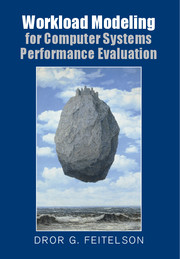Book contents
- Frontmatter
- Dedication
- Contents
- PREFACE
- 1 Introduction
- 2 Workload Data
- 3 Statistical Distributions
- 4 Fitting Distributions to Data
- 5 Heavy Tails
- 6 Correlations in Workloads
- 7 Self-Similarity and Long-Range Dependence
- 8 Hierarchical Generative Models
- 9 Case Studies
- 10 Summary and Outlook
- Appendix Data Sources
- Bibliography
- Index
6 - Correlations in Workloads
Published online by Cambridge University Press: 05 March 2015
- Frontmatter
- Dedication
- Contents
- PREFACE
- 1 Introduction
- 2 Workload Data
- 3 Statistical Distributions
- 4 Fitting Distributions to Data
- 5 Heavy Tails
- 6 Correlations in Workloads
- 7 Self-Similarity and Long-Range Dependence
- 8 Hierarchical Generative Models
- 9 Case Studies
- 10 Summary and Outlook
- Appendix Data Sources
- Bibliography
- Index
Summary
Modeling the distribution of each workload attribute in isolation is not enough. An important issue that has to be considered is possible correlations between different attributes, as well as between different samples from the same distribution.
Correlations are important because they can have a dramatic impact on system behavior. Consider the scheduling of parallel jobs on a massively parallel machine as an example. Such scheduling is akin to 2D bin packing: each job is represented by a rectangle in processors×time space, and these rectangles have to be packed as tightly as possible. Assuming that when each job is submitted we know how many processors it needs, but do not know for how long it will run, it is natural to do the packing according to size. Specifically, packing the bigger jobs first may be expected to lead to better performance [144]. But what if there is a correlation between size and running time? If this is an inverse correlation, we find a win-win situation: the larger jobs are also shorter, so packing them first is statistically similar to using SJF (shortest job first), which is known to lead to the minimal average runtime [418]. But if size and runtime are correlated, and large jobs run longer, scheduling them first may cause significant delays for subsequent smaller jobs, leading to dismal average performance results [449].
TYPES OF CORRELATION
When we say that workload attributes are correlated, we mean that they exhibit similar behavior. For example, if parallel jobs with more than the average number of processes also run for longer than the average runtime, we say that size and runtime are correlated. In probability theory such relationships are represented by the notion of dependence: random variable X is said to be dependent on random variable Y if knowing Y tells us something about the value of X. When X and Y are strongly correlated, we can use Y to actually predict the value of X.
- Type
- Chapter
- Information
- Workload Modeling for Computer Systems Performance Evaluation , pp. 213 - 282Publisher: Cambridge University PressPrint publication year: 2015



